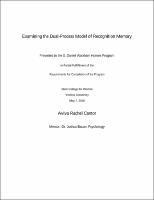Please use this identifier to cite or link to this item:
https://hdl.handle.net/20.500.12202/4461Full metadata record
| DC Field | Value | Language |
|---|---|---|
| dc.contributor.advisor | Bacon, Joshua | en_US |
| dc.contributor.author | Cantor, Aviva Rachel | |
| dc.date.accessioned | 2019-07-03T22:28:23Z | |
| dc.date.available | 2019-07-03T22:28:23Z | |
| dc.date.issued | 2018-05-07 | |
| dc.identifier.citation | Cantor, Aviva Rachel. Examining the Dual-Process Model of Recognition Memory Presented to the S. Daniel Abraham Honors Program in Partial Fulfillment of the Requirements for Completion of the Program Stern College for Women Yeshiva University May 7, 2018. | en_US |
| dc.identifier.uri | https://hdl.handle.net/20.500.12202/4461 | |
| dc.identifier.uri | https://ezproxy.yu.edu/login?url=https://repository.yu.edu/handle/20.500.12202/4461 | |
| dc.description | The file is restricted for YU community access only. | en_US |
| dc.description.abstract | Abstract There are two competing theories of recognition memory. One, known as the dual-process model, posits that recognition memory can be divided into two separate mechanisms that control recognition: recollection and familiarity. The other theory, the strength-based single-process model, proposes that recognition exists along a single continuum. Previous behavioral studies have been divided over this issue, with some providing support of the dual-process model and others using a signal-detection model showing the parsimony of adopting the single-process model. On closer examination of such studies, it appears that testing methods have relied upon many assumptions and data has often been misinterpreted and aggregated. Neurocognitive studies, including lesion studies, fMRI and ERP studies, have given more validity to the dual-process model. However, a true double dissociation study has yet to provide conclusive evidence of the dual-process model, and perhaps the field of memory research has been too quick to accept the dual-process model, ignoring what may be a more accurate single-process model. This paper aims to explore the competing evidence for and against the dual-process model of recognition by reviewing the common methodologies used to test the recollection/familiarity model, examining behavioral and neurocognitive support for recognition models, discussing a number of limitations in the current recognition research, suggesting methodological improvements, and proposing a re-examined model of recognition memory. | en_US |
| dc.description.sponsorship | S. Daniel Abraham Honors Program of Stern College for Women | en_US |
| dc.language.iso | en_US | en_US |
| dc.publisher | Stern College for Women. Yeshiva University.. | en_US |
| dc.rights | Attribution-NonCommercial-NoDerivs 3.0 United States | * |
| dc.rights.uri | http://creativecommons.org/licenses/by-nc-nd/3.0/us/ | * |
| dc.subject | dual-process model | en_US |
| dc.subject | recognition model | en_US |
| dc.subject | honors thesis | en_US |
| dc.title | Examining the Dual-Process Model of Recognition Memory. | en_US |
| dc.title.alternative | Presented to the S. Daniel Abraham Honors Program in Partial Fulfillment of the Requirements for Completion of the Program. | en_US |
| dc.type | Thesis | en_US |
| Appears in Collections: | S. Daniel Abraham Honors Student Theses | |
Files in This Item:
| File | Description | Size | Format | |
|---|---|---|---|---|
| Aviva Cantor - Spring 2018 Senior Project - Final Copy - May 7.pdf Restricted Access | HR/SCW | 248.29 kB | Adobe PDF |  View/Open |
This item is licensed under a Creative Commons License

